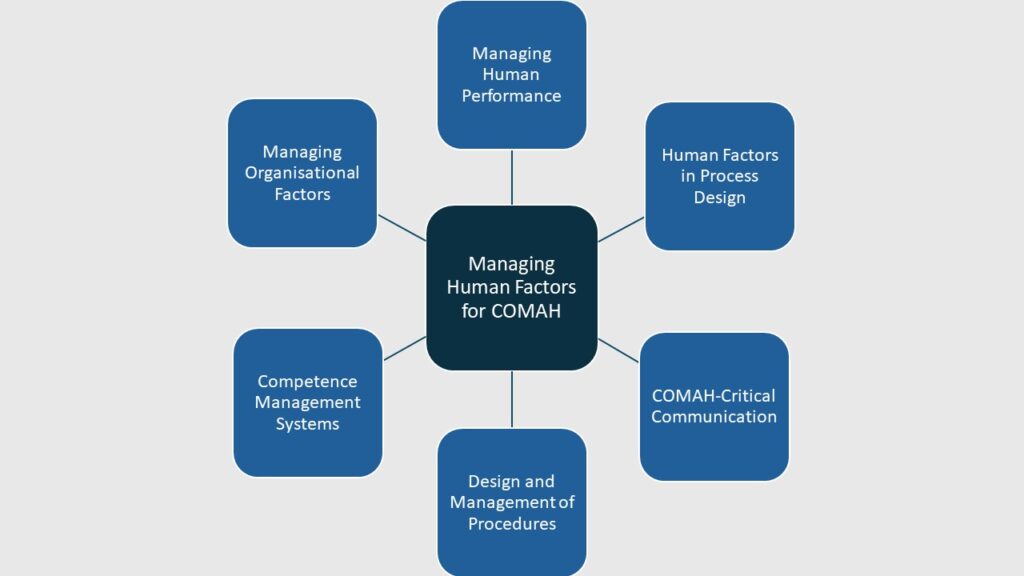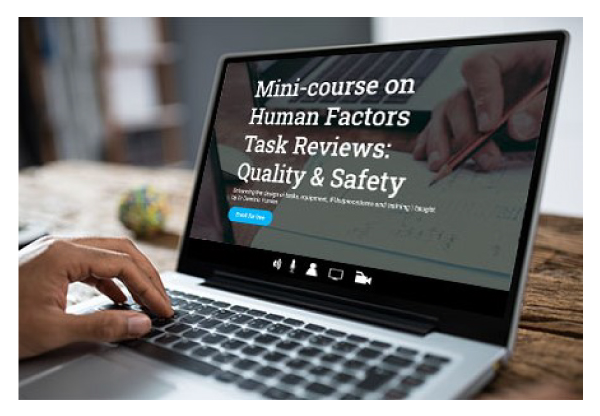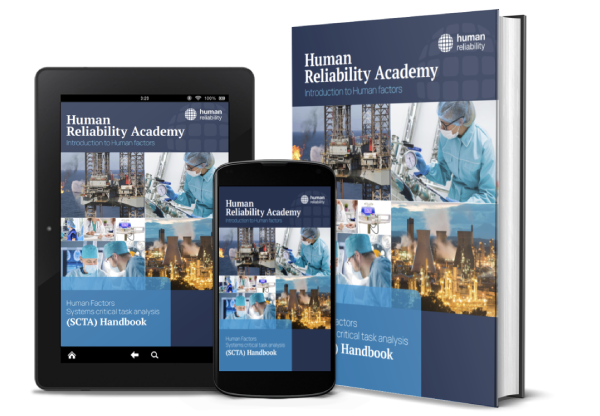In the UK, both upper and lower tier Control of Major Accident Hazards (COMAH) sites must have robust measures in place to prevent major accidents, which could result in significant societal costs and consequences. Recognizing the critical role of Human Factors in preventing such incidents, the UK’s Health and Safety Executive (HSE) published the Human Factors Delivery Guide as a framework for sites to follow.
This guide outlines six key topic areas for managing Human Factors at these sites and presents a Human Factors Roadmap for integrating sustainable human factors management. While the guide is designed for COMAH sites, the principles are equally beneficial for non-COMAH sites.
In this blog, I will provide an overview of the six key topic areas within the guide. If you would like to know more about the Human Factors Roadmap, please visit my other blog here.
The six topic areas

Following a review of various dangerous occurrences and loss of containment incidents in the chemical sector, the COMAH Competent Authority Intelligence Review Group (CAIRG) identified a variety of Human Factors-related issues contributing to these incidents. These topics were later condensed into the six topics we will discuss today.
Topic 1: Managing Human Performance
The first topic, Managing Human Performance, is arguably the most central. It emphasizes the necessity of effective Human Factors risk assessment programs. These assessments help identify safety-critical tasks, understand their vulnerability to human error, and identify factors that can reduce the likelihood of these errors.
Effective risk assessments are essential for identifying potential areas for improving human performance. If these risk assessments are done right, they inform sites on their progress against the remaining key topics in the Delivery Guide.
One way that sites can manage human performance is by conducting MAH risk assessments, such as Safety Critical Task Analysis (SCTA). Briefly, SCTA proactively manages Human Factors risks by evaluating potential human failures, identifying factors that increase the likelihood of failures, and optimising engineering controls and human performance to prevent future incidents. When planning risk assessment programs, sites should include all safety critical tasks, including non-routine tasks such as Maintenance, Inspection and Testing (MIT) activities and emergency plans.
It is equally important to analyse previous incidents to understand their causes and contributing factors. Sites should strive to dive deeper by understanding not just the immediate causes but also the underlying and latent causes that contributed to such incidents. This reactive approach, combined with a proactive risk assessment program, creates a feedback loop that can guide relevant stakeholders in making effective changes to the site.
Topic 2: Human Factors in Process Design
The second topic of the Delivery Guide focuses on plant design and process control systems. Human Factors must be considered during the design process, especially in areas that rely heavily on manual intervention. When planning a new project or making modifications to the plant, sites should develop a structured framework for integrating Human Factors to ensure that all possible Human Factors issues are addressed early.
Process control systems, such as Distributed Control Systems (DCS), Human-Machine Interfaces (HMI), and instruments, can greatly benefit from user-centred designs. These systems should support personnel through optimal layout and equipment design to minimise the likelihood of errors. This can be achieved by referencing relevant Human Factors design standards and undertaking Human Factors assessments to justify the allocation of function within the system.
In addition to process control systems, alarms should be optimised to support personnel with their work. Alarms are critical as they aid in the early detection of potential MAH scenarios and help recover the plant to a safe state. Therefore, it is essential that alarm systems are designed to accommodate human performance limits and assist site personnel in managing process upsets and abnormal situations. Good alarm management can be implemented by assessing the performance of the alarm against relevant guidelines.
Dominic shared an interesting project he developed that highlights how design for even common everyday appliances could leave people confused as part of our Human Factors for Process Design course. Click here to watch the video.
Topic 3: COMAH-Critical Communication
The third Human Factors topic focuses on various communication aspects that, if not well established, could result in unwanted scenarios. This includes both verbal communications, such as shift handovers, and written communications, like permits and log books. In cases where poor communication is identified, sites should review and improve their communication practices and non-technical skills.
Shift handovers should be efficient and meaningful, conveying only relevant information to both parties. This ensures that both outgoing and incoming groups have the same understanding of the plant’s state, reducing the likelihood of any MAH. These handovers should be conducted with sufficient time and, if possible, with supporting communication equipment so that vital information is communicated clearly.
Permits are an example of supporting communication tools. Clearly documented permits inform personnel of the hazards and consequences involved. These permits should be displayed in areas where they are easily visible and accessible to site personnel. In terms of implementing the permits, there should be a clear expectation of how these permits are managed. This can be achieved through good resource planning during permit issuance, reviewing the practices surrounding permit issuance, and clarifying the standards for writing permits.
If you would like to understand how to improve critical communications on your site, our COMAH-Critical Communication Course focuses on raising awareness surrounding the issues related to this topic.
Topic 4: Design and Management of Procedures
Procedures are essential as they outline how a task should be performed. If done right, procedures can highlight critical information and hazards, making them an asset for managing the risks of MAHs. Due to its pivotal role in managing risk, this topic is often reviewed alongside Topic 1: Managing Human Performance.
When preparing procedures, sites should ensure that these documents are written with the end user in mind. They should have good readability, the appropriate level of detail, and clear language. It is also important to have regular input from the users and technical team to ensure that these critical tasks are being performed in a practical manner.
If you’re interested in procedure writing, we previously released a series on best practices for procedure writing. Part 1 recommends some best practices during procedure development, while Part 2 discusses aspects such as the appropriate level of job aids and procedure formatting.
Topic 5: Competence Management Systems (CMS)
Good competence management ensures that site personnel are knowledgeable about the various risks involved and qualified to perform their tasks safely and efficiently. It is closely related to procedure development, as the quality of work performance depends on the training and procedures available to the individual.
Competence management systems should clearly define the qualifications and skills required to perform any safety-critical tasks. These required competencies should be clearly linked to the MAHs identified and must be regularly reviewed. If the personnel lack competence in certain areas, they should be supported with structured training and supervision.
Our senior consultant, Neil Hunter, discussed how an SCTA review highlighted a gap in the competence standards for a site. Read his blog on how you can develop risk-informed competence standards here.
Topic 6: Managing Organisational Factors
The final topic in the Delivery Guide covers organisational factors such as staffing levels, management change, and fatigue.
Key organisational changes should be carried out in a planned and structured manner. This involves assessing the potential hazards and consequences of the changes and implementing adequate control measures to manage the risks arising from them.
Fatigue resulting from poorly managed shift patterns can also impact human performance. If fatigue is identified as a prominent issue, sites should understand its causes, make informed decisions on overtime limits and shift patterns, and educate on the importance of good fatigue management.
Workload and staffing levels are among the other issues mentioned in this topic. Indicators of high workload, such as lack of rest breaks, high staff turnover, and excessive overtime, should prompt a thorough workload assessment with appropriate measures to reduce it. Staffing assessments are also beneficial in establishing the minimum safe staffing levels required for critical tasks to minimise work overload.
HRA previously developed a cognitive workload assessment tool, CLIMATE, to analyse specific work scenarios and their safe working limits. Download the paper here
The six topics outlined in the Delivery Guide are crucial for effectively managing Human Factors within COMAH sites. While these principles are tailored for the process industry, other sectors may have different topics and different content in those topics for good Human Factors management. The Offshore Human Factors Inspection Guide, for instance, addresses the integration of Human Factors in decommissioning projects.
What Human Factors topics are most relevant in your industry? If you work in a sector outside the process industry, we’d love to hear about any similar guidelines or practices you use to manage Human Factors effectively.
If you’re looking to enhance your site’s Human Factors management, check out our Introduction to Human Factors for Process Safety, Loss Prevention, and COMAH (HF_PLC) Course. This course offers valuable resources and tools to help you identify and address Human Factors-related gaps. For more details, click here.
If you want a quick introduction to human factors risk assessment for critical tasks, sign up for our FREE Mini-Course.This course will help you kickstart your Safety Critical Task Analysis (SCTA) journey. Sign up here to get started.














